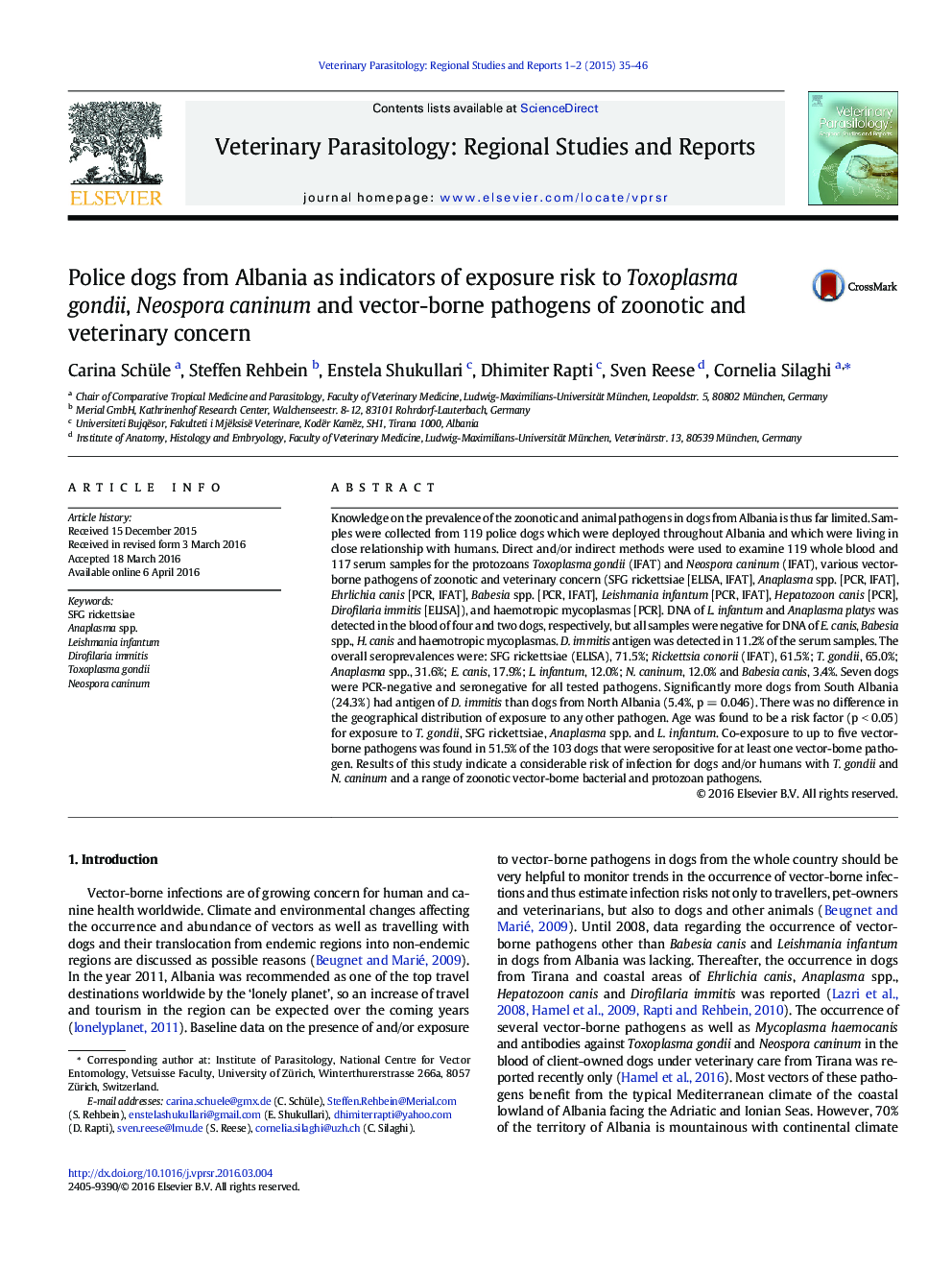| کد مقاله | کد نشریه | سال انتشار | مقاله انگلیسی | نسخه تمام متن |
|---|---|---|---|---|
| 5806475 | 1555871 | 2015 | 12 صفحه PDF | دانلود رایگان |

- Considerable exposure rates to zoonotic pathogens were found in Albanian police dogs.
- The data of the police dogs also reflects an exposure risk for humans.
- Age was found to be a risk factor for exposure to T. gondii, SFG rickettsiae, Anaplasma spp. and L. infantum.
- Significantly more dogs from South-Albania were positive for Dirofilaria immitis.
- Nearly every second dog was seropositive to two vector-borne pathogens or more.
Knowledge on the prevalence of the zoonotic and animal pathogens in dogs from Albania is thus far limited. Samples were collected from 119 police dogs which were deployed throughout Albania and which were living in close relationship with humans. Direct and/or indirect methods were used to examine 119 whole blood and 117 serum samples for the protozoans Toxoplasma gondii (IFAT) and Neospora caninum (IFAT), various vector-borne pathogens of zoonotic and veterinary concern (SFG rickettsiae [ELISA, IFAT], Anaplasma spp. [PCR, IFAT], Ehrlichia canis [PCR, IFAT], Babesia spp. [PCR, IFAT], Leishmania infantum [PCR, IFAT], Hepatozoon canis [PCR], Dirofilaria immitis [ELISA]), and haemotropic mycoplasmas [PCR]. DNA of L. infantum and Anaplasma platys was detected in the blood of four and two dogs, respectively, but all samples were negative for DNA of E. canis, Babesia spp., H. canis and haemotropic mycoplasmas. D. immitis antigen was detected in 11.2% of the serum samples. The overall seroprevalences were: SFG rickettsiae (ELISA), 71.5%; Rickettsia conorii (IFAT), 61.5%; T. gondii, 65.0%; Anaplasma spp., 31.6%; E. canis, 17.9%; L. infantum, 12.0%; N. caninum, 12.0% and Babesia canis, 3.4%. Seven dogs were PCR-negative and seronegative for all tested pathogens. Significantly more dogs from South Albania (24.3%) had antigen of D. immitis than dogs from North Albania (5.4%, p = 0.046). There was no difference in the geographical distribution of exposure to any other pathogen. Age was found to be a risk factor (p < 0.05) for exposure to T. gondii, SFG rickettsiae, Anaplasma spp. and L. infantum. Co-exposure to up to five vector-borne pathogens was found in 51.5% of the 103 dogs that were seropositive for at least one vector-borne pathogen. Results of this study indicate a considerable risk of infection for dogs and/or humans with T. gondii and N. caninum and a range of zoonotic vector-borne bacterial and protozoan pathogens.
This work revealed exposure rates to vector-borne pathogens, Neospora caninum and Toxoplasma gondii from 3.4% up to 71.5% police dogs from different parts of Albania. T. gondii, Anaplasma spp., SFG rickettsiae, Rickettsia conorii, Dirofilaria immitis and Leishmania infantum are zoonotic pathogens; therefore police dogs may be considered as sentinels for the risk of pathogen exposure of their handlers as well as indicators for the presence of pathogens in their environment.
Journal: Veterinary Parasitology: Regional Studies and Reports - Volumes 1â2, December 2015, Pages 35-46